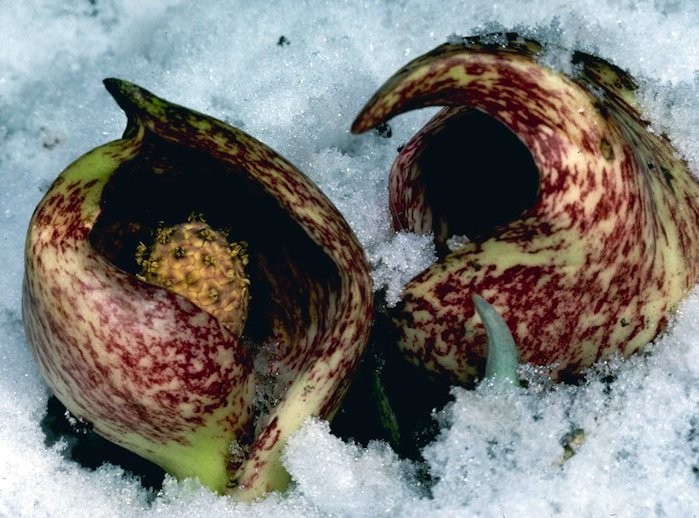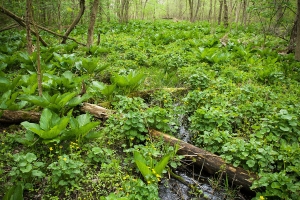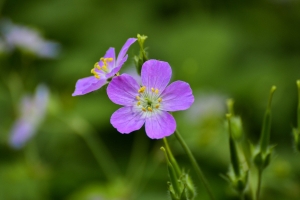
SUNSHINE FARM, W.Va. — Winter and spring may be the best time of year to sing the praises of Symplocarpus foetidus, a.k.a. “Eastern Skunk Cabbage,” because this is when this unusual plant performs a magic trick.
Before I tell you about the magic, let’s dispel an obvious negative. First of all, this plant does not smell at all like a skunk, and although the specific epithet "foetidus" suggests it, this plant does not stink. Of course, should you happen to bruise the foliage, it does present a strange fragrance that some folks may not embrace.

The magic comes in spring as the flower, which is called a spathe and is very similar in design to its cousin, Arisaema triphyllum, aka “Jack-In-The-Pulpit,” stirs up its sexuality and generates enough heat to melt the snow around it as it emerges. Quite a sight!
Symplocarpus foetidus is typically found in very wet soil, such as in wet seeps, bogs, and marshes. That is the best place to locate it in your garden. However, I also have grown it for decades in average garden soil with no supplemental watering. It goes dormant around early summer in that circumstance but, in a wetter location, persists well into autumn.
Here in the Mountain State, we call them “West Virginia Hostas,” as they can resemble a hosta with their huge leaves and robust growth. I’ve had them grow up to almost 36 inches tall and attain spreads of up to 48 inches in years of heavy rainfall—a very imposing stature in the garden.
Once established, they are tough to transplant as the root system can be larger than the plant above ground. They rarely produce offsets, so seed is the best way to propagate them, but you must sow immediately when ripe, as they are very ephemeral.
This giant has no pests, as the foliage contains heavy amounts of oxalic acid, as do all members of the Araceae family. That’s the substance that numbs your tongue when you put a piece of Dieffenbachia in your mouth. Why do you think they call that familiar houseplant “Dumb Cane"?
Philodendron is also a member of the Araceae family, as are many tropical root vegetables. Plants in this family are known as Aroids.
Symplocarpus foetidus has a cousin on the “Left Coast,” Lysichiton americanus, a.k.a.“Western Skunk Cabbage,”—similar in its love of wet feet, but it can’t perform the same magic trick that its eastern cousin can. There is also an Asian cousin, Lysichiton camtschatcensis.
If you have a hospitable area for skunk cabbage, try it. It’s a worthwhile plant to grow and garners many double-takes and conversations from garden visitors. If your garden has no wet-to-moist areas, build yourself a bog, and enjoy many of the cool wetland plants available to the home gardener.
You’d be surprised at the results when you Google “how to create a bog garden.” If you have average soil, don’t be discouraged. You can give this remarkable plant supplemental water with extra mulch and enjoy it for a shorter growing period.
Barry Glick's mountaintop garden and nursery attract gardeners from every country worldwide. He writes and lectures extensively about native plants and hellebores and welcomes visitors with advance notice. He can be reached at barry@sunfarm.com, Sunfarm.com, or 304-497-2208.
Yes, (West) Virginia, there is a native geranium!

Just about everyone is familiar with the houseplant called “geranium” and knows that it hails from South Africa, but they are dumbfounded when I explain to them that the name geranium for that particular plant is somewhat errantly applied. READ BARRY'S FULL COLUMN HERE.
Sign up to receive a FREE copy of West Virginia Explorer Magazine in your email weekly. Sign me up!






























